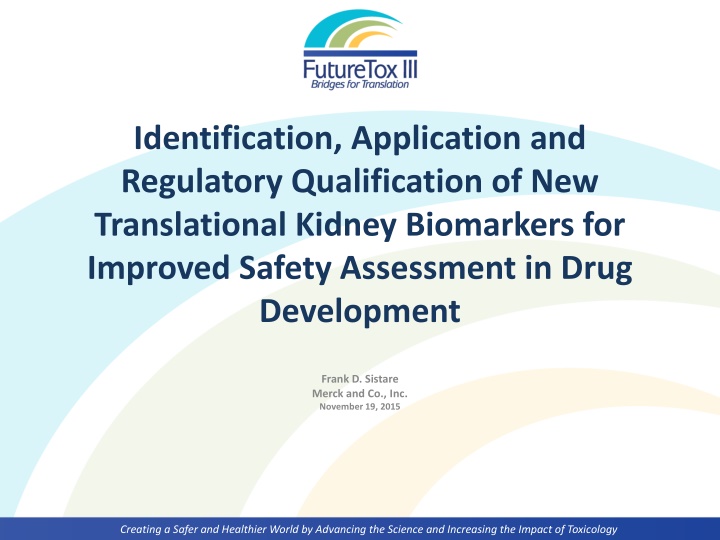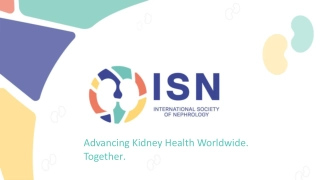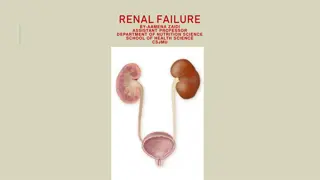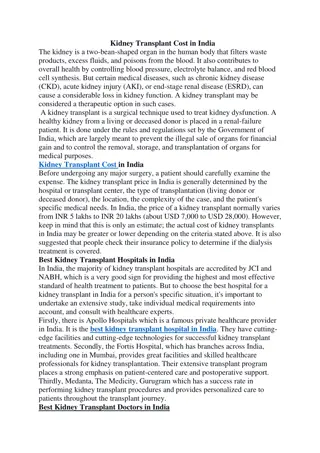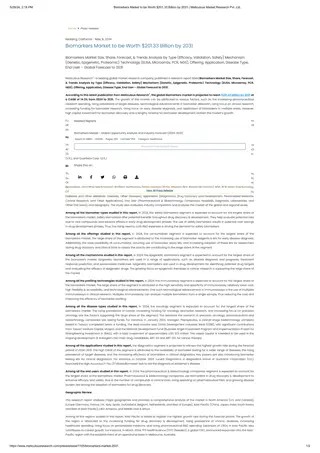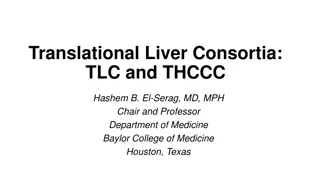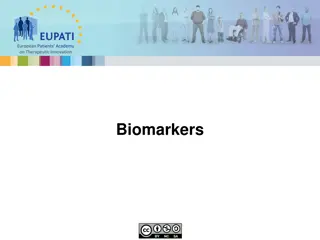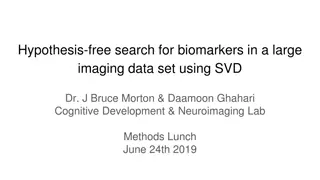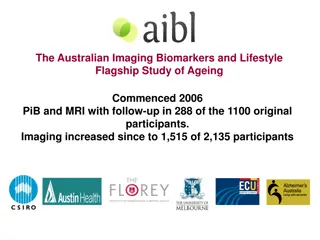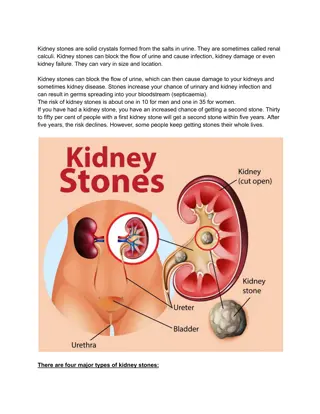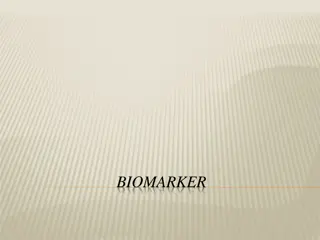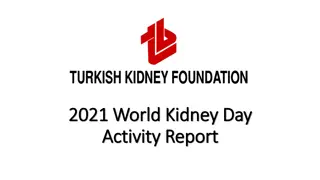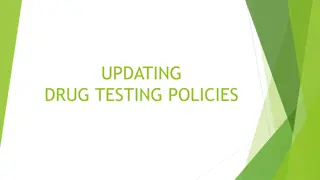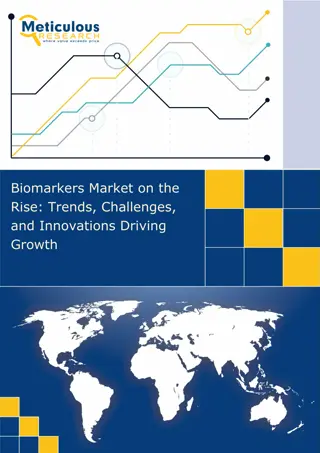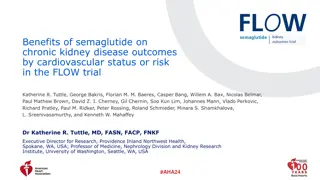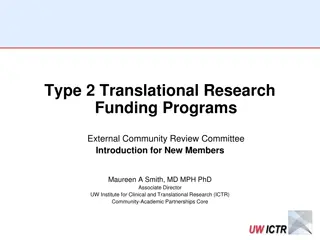New Translational Kidney Biomarkers for Improved Safety Assessment in Drug Development
This research focuses on identifying, applying, and qualifying new translational kidney biomarkers to enhance safety evaluation in drug development. Both EMA and FDA have acknowledged the acceptability of these biomarkers for non-clinical drug development. The hypothesis suggests that these biomarkers will provide early detection, more sensitivity, and additional information compared to conventional markers, ultimately improving patient prognosis and enabling better clinical drug development. Qualification involves linking biomarkers with biological processes and clinical endpoints, emphasizing the importance of evidentiary standards and improved performance relative to traditional biomarkers.
Download Presentation

Please find below an Image/Link to download the presentation.
The content on the website is provided AS IS for your information and personal use only. It may not be sold, licensed, or shared on other websites without obtaining consent from the author.If you encounter any issues during the download, it is possible that the publisher has removed the file from their server.
You are allowed to download the files provided on this website for personal or commercial use, subject to the condition that they are used lawfully. All files are the property of their respective owners.
The content on the website is provided AS IS for your information and personal use only. It may not be sold, licensed, or shared on other websites without obtaining consent from the author.
E N D
Presentation Transcript
Identification, Application and Regulatory Qualification of New Translational Kidney Biomarkers for Improved Safety Assessment in Drug Development Frank D. Sistare Merck and Co., Inc. November 19, 2015 Creating a Safer and Healthier World by Advancing the Science and Increasing the Impact of Toxicology
EMA & FDA - 2008 CPath PSTC Receives Favorable Qualification Decisions Following assessment, both regulatory agencies came to the conclusions that: the renal biomarkers submitted were acceptable in the context of non-clinical drug development for detection of acute drug-induced renal toxicity; the renal biomarkers provide additional and complementary information to the currently available standards; the use of renal biomarkers in clinical trials is to be considered on a case-by-case basis in order to gather further data to qualify their usefulness in monitoring drug-induced renal toxicity in man. Nature Biotech. May 2010; 10 manuscripts.
The Hypothesis: New translational kidney safety biomarkers will: 1)report injuries to different segments of the nephron, 2) respond earlier and be more sensitive than BUN and sCr, 3) report on dysfunction, AND damage, AND histopathologic injury response processes (e.g., degeneration, regeneration, dilitation, etc.) 4) inform patient prognosis, 5) enable clinical drug development. TFF3 * pp 436 - 440 *Ten manuscripts in this issue on the submission of these biomarker data
Qualification is the evidentiary process of linking a biomarker with biological processes and clinical end points Qualification is also that agreement that the evidence gathered is sufficient for a specific context of use EVIDENTIARY STANDARDS THAT WERE ADOPTED: Availability of sufficiently validated analytical assay Biological Understanding: Understanding relevance to toxicity Understanding of mechanism of response Link of biomarker response to observed pathology Improved Performance Relative to Conventional Biomarkers: Consistent response across mechanistically different compounds, and response similar across sex, strain, and species Presence of dose response and temporal relationship to the magnitude of response and injury severity Specificity of response to toxicity understanding the response to toxicities in other tissues, or to pharmacologic effects without toxicity in the target organ 4
Urinary Kidney Biomarkers are more Sensitive than BUN and sCr in a 2-wk NPAA Rat Toxicity Study NPAA 350, 700, 1200 mg/kg/day; SD4, 8, 15 150 Histopath 100 Control grade 0 Treated grade 0 Treated grade 1 Treated grade 2 Treated grade 3 50 Fold Change 8 6 4 2 0 -2 sCr BUN CLU ALB GST- NGAL Kim-1 Clinical Chemistry ELISAs Vlasakova K, et al. Tox Sci. 2014;138:3-20. 5
Kidney Biomarker Performance in 12 Rat Studies: Kim-1 is superior to Serum Creatinine Serum Creatinine Kim-1 3.8 3.6 3.6 1.4 1.4 3.4 3.2 3.2 1.2 1.2 3.0 2.8 2.8 2.6 Fold Change (log10) 1.0 1.0 SCr fold change (log10) 2.4 2.4 Kim1 fold change (log10) 0.8 0.4 2.2 2.0 2.0 0.8 0.8 1.8 1.6 1.6 1.4 0.6 0.6 1.2 1.2 1.0 0.4 0.4 0.8 0.6 0.4 0.2 0.2 0.2 0.0 0.0 -0.2 0.0 0.0 -0.4 -0.4 -0.6 -0.2 -0.8 -0.2 -0.8 -1.0 BAC CARB CPT CS D-S GM HCB NPAA PI DOX PAN Thy BAC CARB CPT CS D-S GM HCB NPAA PI DOX PAN Thy Untreated Control Grade 0 Grade 1 Grade 2 Grade 3 Grade 4 Grade 5 Treated: Studies for both markers in order as follows: bacitracin, carbapenem A, cisplatin, cyclosporin, D-serine, gentamicin, HCB, NPAA, propyleneimine, doxorubicin, puromycin, Thy1.1 Vlasakova K, et al. Tox Sci. 2014;138:3-20.
Kim1 Specificity Kim-1 Data Set Across 10 Rat Specificity Studies 65 Untreated Control Treated Grade 0 60 55 50 45 40 Fold Change Fold change 35 30 25 20 15 10 5 0 TMPD LPS Norethindrone 17a-Ethynylestradiol Cerivastatin Merck A Allylamine Minoxidil Bromobenezene Acetaminophen TMPD LPS NE EE Merck B Merck A AAM MIN BB APAP (TMPD, LPS, norethindrone, ethynyl estradiol, Merck B, Merck A, allylamine, minoxidil, bromobenzene, acetaminophen) 7 Vlasakova K, et al. Tox Sci. 2014;138:3-20.
Summary of Biomarker Performance in 9 Sensitivity and 10 Specificity Studies in Rats Tubular Sensitivity and Specifity Studies Exclusion Model 1.0 1.0 Sensitivity and Specificity Studies Exclusion Model Fold Cut Off Biomarker AUC Sens* Kim-1 0.96 94 2.4 0.9 0.9 Clusterin 0.93 80 3.7 0.8 0.8 Albumin 0.92 73 5.2 0.7 0.7 Osteopontin 0.86 52 7.2 0.6 0.6 Sensitivity Sensitivity Osteoactivin 0.90 66 4.5 0.5 0.5 0.4 0.4 NGAL 0.76 10 20 0.3 0.3 Cystatin C 0.80 37 5.9 0.2 0.2 NAG 0.81 47 2.5 0.1 0.1 RBP4 0.79 61 3.5 0.0 0.0 B2M 0.71 24 11 0.0 0.1 0.2 0.3 0.4 0.5 0.6 0.7 0.8 0.9 1.0 0.5 0.4 0.3 0.2 0.1 0.0 0.6 0.7 0.8 0.9 1.0 Total Protein 0.74 50 2.0 1 - Specificity 1 - Specificity GST- 0.58 44 2.2 Kim-1 NAG Clusterin RBP4 Albumin B2M Osteopontin Total Protein BUN 0.77 46 1.7 sCr 0.72 54 1.1 Osteoactivin GST- NGAL BUN Cystatin C sCr *Sensitivity values at 95% specificity. Vlasakova K, et al. Tox Sci. 2014;138:3-20. 8
14 Day Tobramycin Biomarker Study in 6 Rhesus Monkeys +/- Biopsies Gene Expression @ Day 15 in Tissue Section (Fold Change) Group Animal ID Histopathology @ Day 15 by Full Section Serum Creatinine Urine KIM-1 Urine CLUSTERIN Biopsy Gene Expression (mg/dL) (pg/mg Cr) (ng/mg Cr) (Fold Change) Sample Day Sample Day Sample day Sample Day -4 4 8 11 15 -4 4 8 11 15 -4 4 8 11 15 -4 4 8 11 15 Control w/o Biopsy 1a None 1.0 2.0 Kim1 0.8 0.8 0.7 0.7 BLQ BLQ BLQ BLQ BLQ 68 BLQ 232 165 135 1.0 1.1 Clu 1.0 1.4 Opn 1b None 0.7 0.2 Kim1 0.7 0.8 0.6 0.7 0.7 BLQ BLQ BLQ BLQ BLQ BLQ 846 751 225 168 1.3 1.5 Clu 1.7 2.2 Opn Casts; Needle track inflamm. & hemor. Control w Biopsies 2a 0.6 0.8 19.6 1.1 Kim1 0.7 0.8 0.8 0.8 0.8 BLQ BLQ BLQ BLQ 575 805 1477 1763 647 0.8 1.7 4.2 1.2 Clu 0.2 0.5 3.5 0.6 Opn Casts; Needle track inflamm. & hemor. 2b 0.2 0.2 0.3 0.3 Kim1 0.9 0.8 0.8 0.8 BLQ BLQ BLQ BLQ BLQ 231 BLQ 124 185 2021 1.8 1.4 2.2 1.4 Clu 1.0 0.7 1.6 1.7 Opn Casts; Needle track inflamm. & hemor. PLUS Tubular Dilatation Gr 2 Tobramycin 20 mkd w Biopsies 3a 2.5 2.4 90.7 14.0 Kim1 2.1 2.5 4.2 3.6 Clu 0.7 0.8 0.8 0.9 BLQ BLQ BLQ BLQ BLQ 200 275 285 956 794 0.7 2.3 12.0 4.9 Opn Casts; Needle track inflamm. & hemor. PLUS Tubular Dilatation Gr 2 AND Tubular Degener. Gr 1 3b 1.2 59.0 234.6 66.2 Kim1 3.0 3.1 5.6 5.9 Clu 0.7 0.9 0.7 0.8 0.9 BLQ BLQ 87 311 594 151 312 1925 1921 6555 0.8 2.8 24.8 18.7 Opn (1) No evidence of tobramycin-induced microscopic histopathology was noted in ANY of the biopsy samples (including day 15) (2) The biopsy procedure itself appears to effect urine biomarkers and tissue gene expression, and could cloud interpretation. (3) Urine biomarkers would appear to be the superior translational research tool for interpretation of kidney injury response
7+ Years/2 Clinical Studies 2 Years/34 Animal Studies FDA & EMA Approve COU, SAP (Assay approval pending) Partnering proposal to FNIH BC for Kidney BM clinical qualification Kim-1 clusterin TFF3 albumin First submission FDA, July Total protein B2 microglobulin Cystatin C Project plan approved Launch of 2 clinical studies 2007 2006 2008 2009 2010 2011 2012 2013 2014 2015 2016 2017 Limited COU FDA & EMA Submission FDA & EMA support qualification claims for 7 biomarkers for nonclinical & limited clinical use 34 studies Expected clinical data FINAL Qualification Submission Funding, contracts, protocols, assays, legal agreements, etc Formation of PSTC Summary of hypothetical but reasonable examples of drug development scenarios that support the patient health, scientific and business case for qualifying new translational safety biomarkers. [Sistare, Frank D and DeGeorge Joseph J, Biomarkers Med 2011 5(4) 497-514] Phase of Development Example Summary Description Estimated Benefit from Deploying New Safety Biomarker Pre-Candidate Selection Phase Applications #1 Renal Injury De-Risked at Cmpd Selection NHP exhibits renal tox with lead that is thought to be human relevant. 3 candidates selected for minimal study using renal biomarker longitudinal measurements. Safest of 3 candidates selected for development to minimize drug development delay. Preclinical GLP Animal Toxicology Studies and / or Clinical Trials #5 Rat-only Kidney Pathology First Seen in Chronic Study New translational kidney biomarkers demonstrate monitorability of kidney toxicity. Shorter rat studies and chronic monkey studies are negative. Clinical studies show no changes in kidney biomarkers. Ambiguities about human safety concerns are eliminated. $31M+ in clinical development preserved. Delays in development avoided. #6 Dog-only Kidney Pathology Seen in First GLP Study New translational kidney biomarkers demonstrate monitorability of kidney toxicity seen only in Dog w medium margin. Clinical studies conducted show no changes in kidney biomarkers. Ambiguities about human safety concerns are eliminated. $10M+ in preclinical development preserved. Delays in development avoided. 10
FNIH BC/ CPath PSTC Kidney Translational Safety Biomarker Clinical Qualification Project Objective To provide the data needed to advance the clinical qualification and broader acceptance of new translational biomarkers for monitoring kidney safety that would support early clinical drug development Learn and Confirm Strategy Retrospective analysis: Use an existing set of freezer samples from malignant mesothelioma patients treated with cisplatin, some meeting established criteria for AKI (e.g., 50% rise of sCr) + set of control samples from NHV Select biomarkers; establish assays; set thresholds for each biomarker; formulate adjudication guidelines for the second confirmatory prospective phase Prospective analysis: 2 clinical trials
Prospective Trials Design Cisplatin & Aminoglycoside selected because they are SOC agents, known to cause kidney tubule injury, w documented incidence rates in sCr rises 100 patients (50 Ctrls), blood and urine 100 patients (50 Ctrls), blood and urine Aminoglycosides in patients with cystic fibrosis Cisplatin in patients with certain cancers First site USC PI: Paul Beringer First site U. of Minnesota PI: Joanne Billings First site MD Anderson PI: Ala Abudayyeh First site Dana Farber PI: Sus Waiker Third site U. of Utah PI: David Young Fourth site in contracting Denver National Jewish Health PI: Mimi Saavedra Nov 1, 2015 Status: 78% recruitment Nov 1, 2015 Status: 34% recruitment
Learning Phase Data Summary: 8 Selected Urinary Biomarkers Show Improved Sensitivity Over sCr to Identify Patients Exposed to Cisplatin Mesothelioma Patients: Number/N (%) >TSS* Normal Healthy Volunteers: % >TSS Patients With Medically Relevant Increases in sCr Patients Without Medically Relevant Increases in sCr Normal eGFR No Cisplatin (N = 80) Biomarker Clusterin 19/20 (95.0%) 22/30 (73.3%) 1.3% Osteopontin 20/20 (100.0%) 30/31 (96.8%) 5.1% Microalbumin 20/20 (100.0%) 30/30 (100.0%) 2.5% Total Protein 20/20 (100.0%) 30/30 (100.0%) 3.8% NAG 20/20 (100.0%) 27/30 (90.0%) 0% Kim-1 20/20 (100.0%) 30/30 (100.0%) 1.3% Cystatin-C 19/20 (95%) 22/30 (73.3%) 5.1% NGAL 19/20 (95%) 24/30 (80.0%) 4.1% *TSS = statistically significant threshold. 13
Increases in Sensitivity while Maintaining Specificity X (%) with 1 BmX > TSS 16 (21%) X (%) with 2 BmX > TSS 2 (3%) X (%) with 3 BmX > TSS 0 (0%) X (%) with 4 BmX > TSS 0 (0%) X (%) with 5 BmX > TSS 0 (0%) X (%) with 6 BmX > TSS 0 (0%) X (%) with 7 BmX > TSS 0 (0%) X (%) with 8 BmX > TSS 0 (0%) Cohort N Jasper NHV Cohort 76 Meso Patients With Medically Relevant Increases in sCr 20 20 20 20 20 20 19 17 20 (100%) (100%) (100%) (100%) (100%) (100%) (95%) (85%) Meso Patients Without Medically Relevant Increases in sCr 30 30 30 30 29 28 23 16 30 (100%) (100%) (100%) (100%) (97%) (93%) (77%) (53%) Statistical analysis plan (SAP) alignment with FDA/ EMA includes both human adjudication , and automated rules analyses based confirmations Automated rules analysis SAP includes a statistical step- down approach to fairly assess the comparative value of using fewer than the 8 biomarkers
A Progressive Clinical Qualification Framework for Translational Safety Biomarkers Qualification Path Letter of Support Qualification (1) Qualification (2) Extended CoU Qualification Confirmatory / Prospective Studies Publications Limited CoU Qualification Exploratory / Learning Phase Data Publications Aspirational CoU Letter of Support Data Package Publications COU Data Study Design Toxicants Publications Clinical Nonclinical 16
A Limited Context of Use Proposal Intent To encourage the use of 6 novel biomarkers in Phase 1 NHV SAD or MAD clinical trials as a calculated composite group mean (used in conjunction with sCr, BUN, Total Urinary Protein, and Urinary Albumin) to estimate the probability of deviation of a dose cohort from normal variability Overview of the Approach Limited Context of Use for a Composite Measure (CM) is NOT intended for individual patient safety monitoring. The goal of the Prospective Studies will be to qualify biomarkers for individual patient safety monitoring. Use of the CM leverages the learning phase clinical data and allows Sponsors to gain experience and define an acceptable risk tolerance based on the benefit/risk associated with the indication under investigation A proposal has been submitted to FDA and EMA in July 2015 for consideration in parallel to the Full Clinical Qualification Process 17
Clinical Translation Post Lead Lead PreClinical Development Pre Lead ID Filing Marketing Identification Optimization Single Candidate Selection Summary of hypothetical but reasonable examples of drug development scenarios that support the patient health, scientific and business case for qualifying new translational safety biomarkers. [Sistare, Frank D and DeGeorge Joseph J, Biomarkers Med 2011 5(4) 497-514] Phase of Development Example Summary Description Estimated Benefit from Deploying New Safety Biomarker Pre-Candidate Selection Phase Applications #1 Renal Injury De-Risked at Cmpd Selection NHP exhibits renal tox with lead that is thought to be human relevant. 3 candidates selected for minimal study using renal biomarker longitudinal measurements. Safest of 3 candidates selected for development to minimize drug development delay. Preclinical GLP Animal Toxicology Studies and / or Clinical Trials #5 Rat-only Kidney Pathology First Seen in Chronic Study New translational kidney biomarkers demonstrate monitorability of kidney toxicity. Shorter rat studies and chronic monkey studies are negative. Clinical studies show no changes in kidney biomarkers. Ambiguities about human safety concerns are eliminated. $31M+ in clinical development preserved. Delays in development avoided. #6 Dog-only Kidney Pathology Seen in First GLP Study New translational kidney biomarkers demonstrate monitorability of kidney toxicity seen only in Dog w medium margin. Clinical studies conducted show no changes in kidney biomarkers. Ambiguities about human safety concerns are eliminated. $10M+ in preclinical development preserved. Delays in development avoided. 18
What about Translation to Lead Op and even Lead ID Applications?
FNIH BC/CPath PSTC Kidney Safety Biomarker Project Team Merck Animal Study Data Merck Irene Nunes, Elizabeth Ommen, Frank Sistare, Michael Tanen, Michael Topper Amgen Wayne Tsuji Katerina Vlasakova Zoltan Erdos Wendy Bailey Kathy McNulty Valerie Chapeau-Campredon Nathalie Mokrzycki Nagaraja Muniappa Sean Troth David Gerhold Dan Holder Yi-Zhong Eddie Gu Warren Glaab Takayuki Tsuchiya Robert Peiffer Larry Handt AstraZeneca Scott Adler PSTC Stefan Sultana (Novartis) Jaromir Mikl (Boehringer-Ingelheim) Steven Piccoli (BMS) Brigham & Women s Hospital/ Dana Farber Sushrut Waikar, Robert Haddad Pfizer Gary Friedman Denver National Jewish Hospital Mimi Saavedra University of Minnesota Joanne Billings C-Path Amanda Baker, Martin Cisneroz, Nicholas King, Gary Lundstrom, John- Michael Sauer, Elizabeth Walker University of Alabama at Birmingham Gary Cutter, David Warnock FDA Melanie Blank, Aliza Thompson University of California, San Diego Ravindra Mehta FNIH Jessica Ratay, Maria Vassileva University of Southern California Paul Beringer Johnson & Johnson James Lenhard, Robin Mogg Mesothelioma Learning Phase Data University of Texas MD Anderson Cancer Center Ala Abudayyeh, Bonnie Glisson Lilly James Voelker Joseph Bonventre Sushrut Waikar NIH/NIDDK Paul Kimmel University of Utah David Young 20
